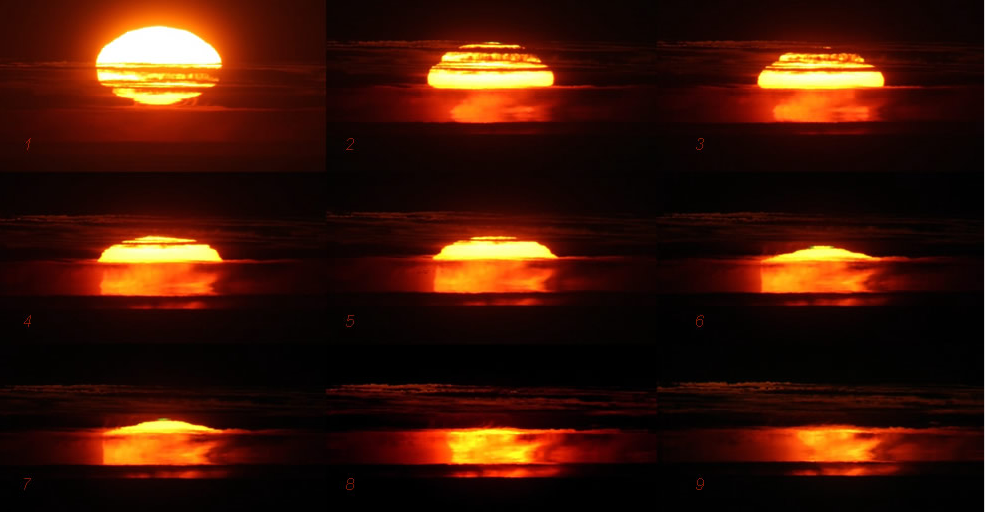Ducted Mock Mirage Green Flash
Ducted Mock Mirage Green Flash: A Fascinating Atmospheric Phenomenon
Have you ever witnessed a breathtaking optical illusion in the sky? One such phenomenon is the ducted mock mirage green flash. This captivating event occurs when rays of light become trapped in inversion layers, forming a duct. Within this duct, an inverted image of the sun ascends while an erect image descends, creating a stunning display. The diminutive green flash can be observed above the duct, adding an extra touch of magic to the scene. In this article, we will delve into the intricacies of this atmospheric optics phenomenon and explore its mesmerizing characteristics.
Understanding the Ducted Mock Mirage Green Flash
The ducted mock mirage green flash is a variant of the well-known green flash, which is typically observed during sunset or sunrise. It is caused by the refraction of sunlight as it passes through layers of the Earth's atmosphere. However, in the case of the ducted mock mirage green flash, the phenomenon occurs within an inversion layer, where temperature increases with altitude instead of the usual decrease. This inversion layer acts as a duct, confining the rays of light and allowing for the formation of inverted and erect images.
The Mechanics Behind the Phenomenon
To understand how the ducted mock mirage green flash occurs, let's break it down step by step:
- Rays of sunlight pass through an inversion layer, where temperature increases with altitude.
- As the rays traverse this layer, they undergo refraction due to the changing density of the air.
- The refracted rays become trapped within the inversion layer, forming a duct.
- Inside the duct, an inverted image of the sun ascends while an erect image descends.
- This inversion creates a mirage-like effect, where objects appear distorted or displaced.
- Finally, as the sun nears the horizon, a diminutive green flash can be observed above the duct, adding a touch of ethereal beauty to the scene.
Factors Influencing the Ducted Mock Mirage Green Flash
Several factors contribute to the occurrence and visibility of the ducted mock mirage green flash. These include:
-
Atmospheric Conditions: The presence of a stable inversion layer is crucial for the formation of the duct and the subsequent mirage effect. Additionally, the absence of significant atmospheric disturbances, such as clouds or haze, enhances the visibility of the phenomenon.
-
Altitude and Distance: The height of the inversion layer and the distance between the observer and the duct play a role in determining the clarity and prominence of the green flash. Higher altitudes and closer proximity to the duct generally result in a more vivid display.
-
Sun's Position: The angle at which the sun approaches the horizon affects the duration and intensity of the green flash. A slower descent allows for a longer observation period, while a steeper descent may produce a more pronounced flash.
Captivating Examples of Ducted Mock Mirage Green Flash
The allure of the ducted mock mirage green flash has captured the attention of many photographers and sky enthusiasts. Here are a few captivating examples:
-
Mila Zinkova's Sequence: In November 2005, Mila Zinkova captured a mesmerizing sequence of the ducted mock mirage green flash over the Pacific Ocean. The images, read from left to right, showcase the inverted and erect images within the duct, with the diminutive flash appearing above. The entire sequence is enhanced by delicate threads of cloud, adding an extra layer of beauty to the phenomenon.
-
Global Sightings: Although relatively rare, sightings of the ducted mock mirage green flash have been reported worldwide. From coastal regions to high-altitude locations, fortunate observers have been treated to this extraordinary display of atmospheric optics.
Conclusion
The ducted mock mirage green flash is a captivating atmospheric phenomenon that combines the enchantment of a green flash with the intrigue of mirage-like effects. This optical illusion, created within inversion layers, offers a unique spectacle for those fortunate enough to witness it. Factors such as atmospheric conditions, altitude, distance, and the sun's position all contribute to the visibility and intensity of the green flash. So, keep your eyes peeled during sunrise or sunset, and you may be rewarded with a glimpse of this extraordinary phenomenon, painting the sky with a touch of emerald brilliance.

Another mock mirage green flash sequence by Mila Zinkova taken over the Pacific Ocean in November '05. Read the images from left to right. Rays are trapped in the inversion layers forming a duct. Inside the duct an inverted image of the sun ascends and an erect image descends. The diminutive flash is above the duct on frames 6 and 7. The whole sequence is seen through threads of cloud. Images ©Mila Zinkova, shown with permission.
Note: this article has been automatically converted from the old site and may not appear as intended. You can find the original article here.
Reference Atmospheric Optics
If you use any of the definitions, information, or data presented on Atmospheric Optics, please copy the link or reference below to properly credit us as the reference source. Thank you!
-
<a href="https://atoptics.co.uk/blog/ducted-mock-mirage-green-flash/">Ducted Mock Mirage Green Flash</a>
-
"Ducted Mock Mirage Green Flash". Atmospheric Optics. Accessed on April 16, 2024. https://atoptics.co.uk/blog/ducted-mock-mirage-green-flash/.
-
"Ducted Mock Mirage Green Flash". Atmospheric Optics, https://atoptics.co.uk/blog/ducted-mock-mirage-green-flash/. Accessed 16 April, 2024
-
Ducted Mock Mirage Green Flash. Atmospheric Optics. Retrieved from https://atoptics.co.uk/blog/ducted-mock-mirage-green-flash/.